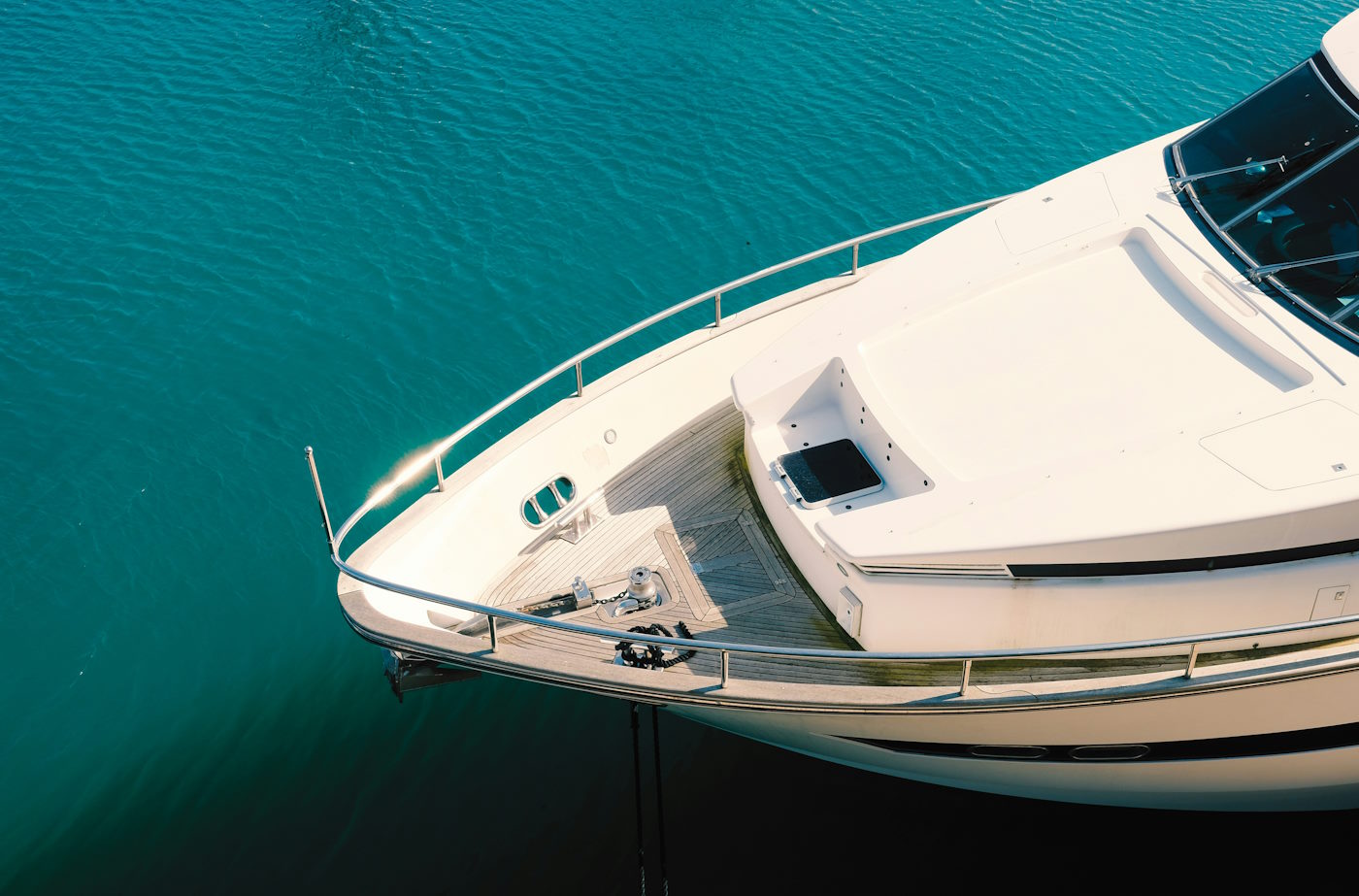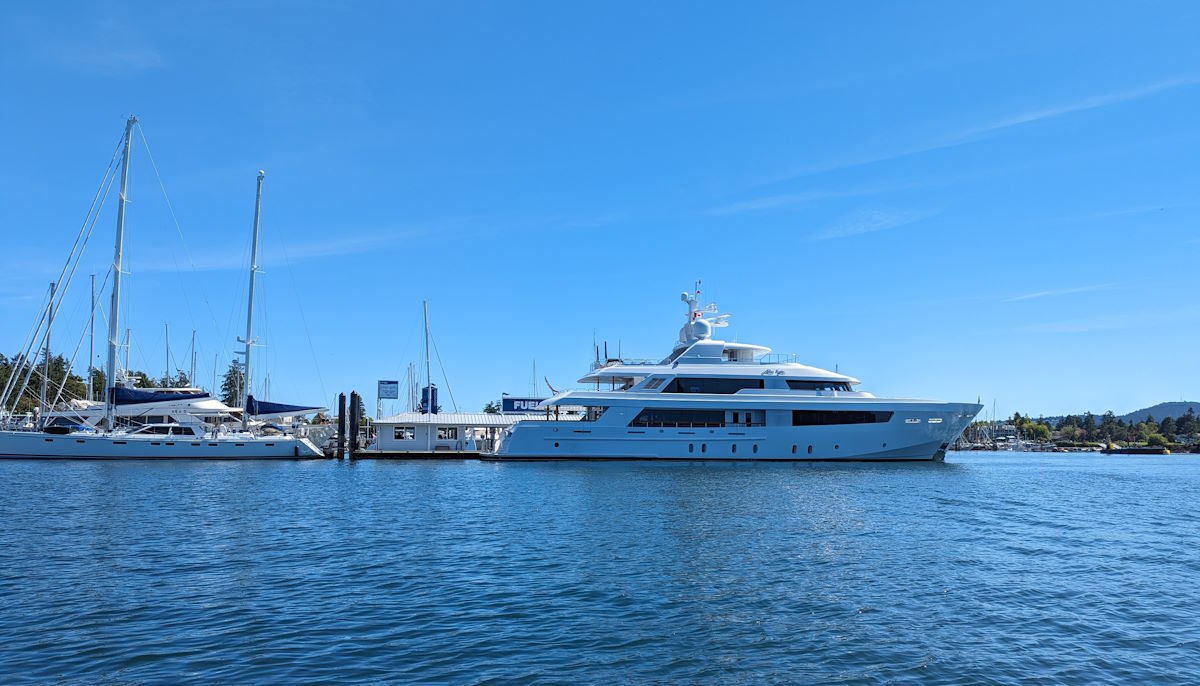What’s the Difference Between a Boat and a Yacht?
If you’re in the market for a new boat, you may be weighing your options between a powerboat, a yacht, or something else. But what’s the difference? To help you choose a craft that best suits your lifestyle and needs, this article is going to weigh the main differences between a boat and a yacht.
Boats and Yachts

With so many different types of yachts to choose from, it can be hard to know your Flybridges from your Tri-Decks if you’re just starting your search. Although there is a growing number of terms used to describe the different types of yachts out there, many of the terms overlap or are used interchangeably.
If you’re on the market for a yacht, the team here at Van Isle Marina has compiled a review of the different terms you’ll likely come across when cruising through yachts for sale.
The term ‘boat’ is used to describe any water vessel, propelled by either sails, an engine, or manpower. It’s not very specific, which means yachts, dinghies, and everything in between technically fall under the blanket term ‘boat’.
The term ‘yacht’ brings a little more prestige and sophistication with its origin story, being derived from the word “hunter” in Dutch. Hundreds of years ago, the Dutch navy built and sailed yachts to literally hunt down pirate ships in shallow waters. That’s part of the reason why both powerboats and sailboats can be classified as ‘yachts. It didn’t take long for other nations to catch on, using the Dutch idea for navy ships and eventually racing vessels and private, recreational vessels.
Size
The size is one of the most common factors used to determine whether a boat should be classified as a yacht or not. When it comes to size, there are no official rules, so it depends on who you ask. Some will say the boat needs to be at least 35 feet to qualify as a yacht – others will say even longer. If you’re yacht is more than 75 feet, you’re approaching Super Yacht range, and if it’s more than 250 feet you’re in Mega Yacht territory.
Despite the uncertainty around size-based classification, typically, you’ll know it when you see it. That massive vessel that looks like it could sleep a 10+ and needs a dozen ropes to secure it to the dock? That’s definitely a yacht. And that small, single-level boat with not a lot of room to stand? That’s definitely a boat.
The downside of using size as the only determining factor is it’s black and white. If you set the boundaries with size, there’s no room for gray area. Let’s explore more…
Luxury Living

Yachts are an international symbol of luxury and wealth around the world. The yacht is synonymous with luxury, which can actually help us when classifying boats as yachts or not. If the boat is built with luxury top of mind, it is probably a yacht.
How do you spot luxury? From the shore, the exterior of a yacht is typically sleeker with distinct accent styles. But the real luxury becomes evident when you step on board. Yachts are built with spacious living areas, full-size kitchens and bathrooms, advanced TV and audio systems, and designer-style furnishings. You might even find hot tubs, a pool, and a helicopter pad in ultra-luxurious cases.
Price
If you’re closing in on the purchase of your new boat and you’re still unsure whether it’s a yacht or not, the price tag should give you some indication. Yachts are known to cost far more than boats, due to their level of luxury and comfort, size, and usage. For a brand-new yacht, you can easily pay $100,000+ per foot, which means you’re looking at millions of dollars for the total price.
There are other costs to consider as well. Because yachts are larger, most will require a professional crew (or at least a captain) on board. Then there’s maintenance and insurance, both of which will cost more for a yacht.
Usage

Another key differentiator between boats and yachts is their purpose – what they’re being used for out on the water. There is no nailed-down definition of what makes a yacht a yacht, but most boaters consider a yacht to be any type of sea vessel that is used strictly for recreational or pleasure purposes, like cruising, entertaining, water sports, fishing, or year-round accommodations.
The only purpose of a yacht is recreation. But more specifically, yachts are designed for personal pleasure and leisure, whether that’s long, ocean-crossing journeys or anchoring near a buzzing port town.
On the other hand, if the vessel is doing a job or being used for a specific activity, it’s not a yacht. If the boat is involved in any commercial activity, it’s only a boat. Even if it’s being used recreationally, for example, fishing or watersports, the boat is still a boat.
Handling Conditions

When you’re out on the open ocean, you’ll have high winds and dangerous waters to deal with. In these conditions, size will definitely work to your advantage. And while you’re closer to shore, you can expect the conditions to be much calmer.
When it comes to dealing with conditions, one worthwhile classification system places boats into one of 4 categories, labelled A through D:
Class A: These are large yachts capable of handling high winds (force 8 on the Beaufort scale) and up to 13-foot waves in the open ocean. These boats are certainly yachts and are built for the open ocean.
Class B: While these yachts aren’t quite designed for the open ocean, they’re very capable craft. Also known as “offshore vessels”, Class B yachts are best suited for waters less than 200 miles (321km) from shore.
Class C: Class C boats are typically known as ‘boats’, as they’re designed for inshore and nearshore excursions – not the open ocean. These boats are fine with waves a few feet high, but anything higher than that is dangerous.
Class D: These boats are typically small ones and are not built for harsh conditions. These crafts can handle winds of up to 25km/hour and waves just a couple of feet high.
Types of Yachts
A yacht is first defined either as a sailing yacht, motor yacht, or gulet yacht, and then as a sports yacht or luxury yacht.
- Sailing Yacht: a yacht mainly propelled by wind and sails
- Motor Yacht: a yacht propelled via one or more motors
- Gulet Yacht: a hybrid yacht with both sails and motors
- Open Yacht, Cruiser, Cabin Cruiser, Express Cruiser: an otherwise uncategorized standard yacht for cruising and entertaining
- Luxury Yacht: a yacht that includes high-end finishes and features, and the latest in modern performance technology. The term ‘luxury’ can precede any type of yacht, i.e. “luxury motor yacht”, “luxury sailing yacht”, etc.
- Sports Yacht: a yacht geared towards fishing, water sports, or cruising with a sleeker design and more powerful motor for faster cruising speeds. The term ‘sports’ can precede other types of yachts as well, i.e. “sports motor yacht”.
- Catamaran Yacht: a yacht with two hulls (pontoons), often made of fibreglass, that can be used in shallow waters.
Yacht Style Categories

Yachts can further be grouped or defined according to their form and function, such as with flybridge, sedan, pilot house, and sportfish yachts, for example.
- Classic Motor Yacht: a yacht that was built between the 1920s and 1970s (before today’s modern technology began dominating modern yacht manufacturing). A modern yacht can be built based on the classic motor yacht style.
- Sedan: a popular yacht style with deck space above the hull and living quarters below. The living quarters of a sedan yacht are enclosed and single-level.
- Flybridge: a sedan-style yacht with an open deck and more comfortable living space above the main bridge of a vessel.
- Daybridge: a multi-level yacht that is even more open than a flybridge. Belize Motoryachts are known for creating this distinctive style of yacht.
- Open or Enclosed: a term used to describe the layout of and access to the flybridge. In an enclosed flybridge, access to the above flybridge is enclosed inside the living space. In an open flybridge, access to the flybridge above is open to the elements.
- Downeast Style: a low-profile yacht with a large working cockpit and small helm station. This highly recognizable style is inspired by the mid-1900s traditional Maine lobster boat. Back Cove yachts are a shining example of downeast-style inspired yachts.
- Pilothouse: A multi-deck yacht, like a flybridge with a larger interior main deck.
- Sky Lounge: an enclosed area at the top of the vessel that provides the benefits of the view but with several amenities, protection from the elements, expansive windows and sometimes a sunroof.
- Cockpit Motor Yacht: a yacht with more cockpit space than deck space.
- Sportfish or Sport Fishing Yacht: A yacht used for fishing with a large cockpit, storage space, and the ability to handle rougher seas. These can also be referred to as Flybridge Sportfish or Sportfish Express and are built for longer durations out on the water.
- Convertible: a yacht that combines features of a standard motor yacht with a sportfish yacht to have entertaining space when you need it, and also fishing space when you need it.
- SUV: a yacht that combines features of a standard motor yacht and a sport yacht.
- Tri-Decks: a superyacht with three levels of staggered, enclosed living space.
- Expedition Yachts: a large yacht with a deeper displacement hull for more stability and comfort during longer-range trips.
There are dozens of governing bodies, societies, and other organizations that set standards, classifications, and definitions in the world of boating. There are different authorities like this all over the world, so it’s a good idea to check in with local groups or areas you plan to visit.
If you’re in the market for a new boat or yacht, head over to Van Isle Marina on Harbour Road in Sidney, BC. You can browse our selection of yachts for sale on our website, but be sure to stop by the marina to check out our facilities, fuel dock and West Coast Waterfront Grill.